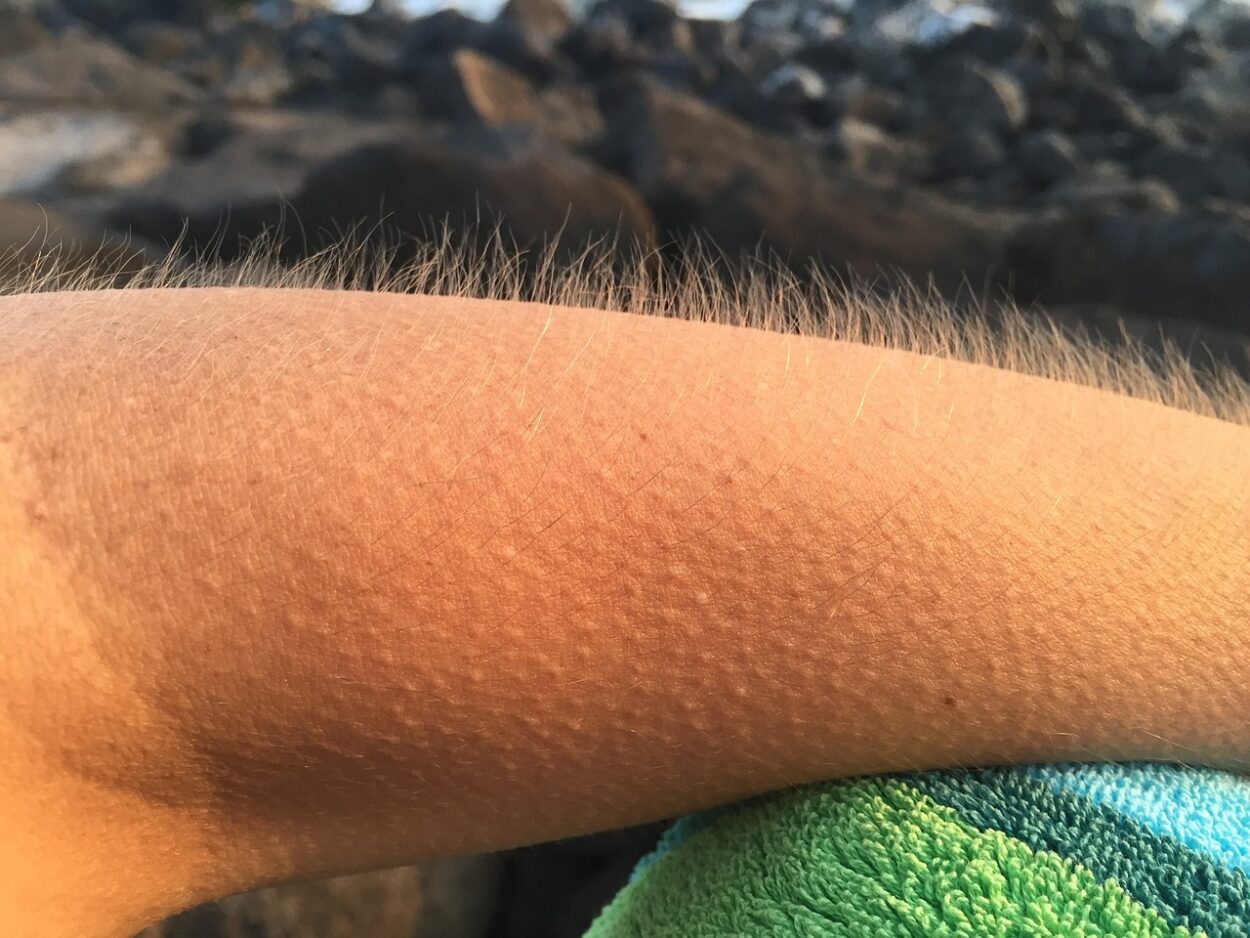Ever had your skin crawl and feel your hairs stand on end? Goosebumps, also known as gooseflesh or piloerection, occur when your body is triggered by intense emotions like fear, surprise or sexual arousal.
Your brain sends signals to the arrector pili muscles, which cause your body hair to rise straight up. The sensation is also experienced by animals who want to appear larger and more intimidating to predators.
Afraid or Startled
Goosebumps often occur when a person is scared, startled or anxious. They are involuntary and happen when the nerves of the sympathetic nervous system, tied into the fight or flight response, stimulate the arrector pili muscles that control hair follicles to raise up. This causes the small bumps on the arms, legs and back of the neck known as goosebumps. Adrenaline, a chemical released by the body when frightened or stressed, can also trigger them. Certain drugs that affect the same chemicals in the brain can also give a person goosebumps, such as methamphetamine and opioids.
People can get goosebumps from a variety of things, from a chill in the air to a rousing crescendo of music or an emotional scene in a movie. They can also occur when someone experiences an intensely pleasurable experience, such as being touched by a loved one or watching a touching film. Goosebumps can also be a result of some medical conditions, such as keratosis pilaris or autonomic dysreflexia, which occurs when the autonomic nervous system overreacts to pain and causes the limbs to twitch.
Experts believe that goosebumps are an evolutionary remnant of our ancestors, who used to use them to appear larger and scare off predators. They are also used to ward off cold temperatures by making the fur of animals stand up, which increases their surface area and keeps them warmer. The reaction is also found in other mammals, such as porcupines when they puff out their quills to deter predators and sea otters raising their fins when threatened by sharks.
Awe or Joy
When you hear a stirring orchestral crescendo, watch an inspiring speech or read a book that touches your heart, you may experience goosebumps on your arms or cheeks. This involuntary physical reaction to awe-inspiring experiences is also known as frisson or the chills and it’s the same reaction that animals experience when they feel threatened or scared. The word goosebumps is also used figuratively to describe that feeling of getting the willies or the creeps, which are similar to what you get when watching a scary movie in a dark room.
It’s likely that goose bumps are a remnant of an evolutionary survival mechanism for mammals. When many fur-covered animals feel fearful, their hair stands up to make them appear larger and more intimidating in a fight or flight response, the same mechanism that triggers goosebumps in humans. For example, the puffed up hairs on a porcupine’s quills serve to deter predators.
Goosebumps occur when the body releases hormones that tighten the tiny muscles around the root of each hair, which causes the hair to stand up and create small bumps on the skin, Dr. Jen Caudle tells Yahoo Life. These muscles are called the arrector pili, and unlike skeletal muscles, which you can control voluntarily, you can’t consciously contract these smooth muscles. Goosebumps are rarely a cause for concern, but they can be a sign of some medical conditions, like keratosis pilaris, autonomic dysreflexia or temporal lobe epilepsy.
Sexual Arousal
You may have noticed that you get goosebumps when a cool breeze brushes your bare skin or when you are watching a scary movie. Goosebumps can be triggered by any emotion, but they are most common when you feel fear or startled. They are a natural part of our evolutionary heritage, as they allow us to raise our skin and expose more of our body to potential danger.
Other emotions that can prompt goosebumps include awe or joy, which is what R.L. Stine probably had in mind when he dubbed his creepy stories with the title Goosebumps. You can also get goosebumps when you are sexually aroused, but you must have enthusiastic consent from your partner. In fact, it’s not uncommon for women to get goosebumps before a romantic encounter because the nervous system triggers a pre-romantic response in order to prepare your body for a climax.
Psychological and neuroscientific studies have shown that goosebumps occur during moments of peak emotional arousal, such as when you listen to emotionally stirring music or watch a moving film. Studies have even found that goosebumps and tears often overlap.
If you never experience goosebumps, you might have a condition called keratosis pilaris, which causes tiny, rash-like bumps on the skin that look like sand-grains. It usually occurs on the legs, thighs and cheeks but can also appear on the arms and butt. You can usually prevent keratosis pilaris by using a moisturizer with exfoliant properties.
Cold Temperature
Goosebumps are a common phenomenon that happens when something causes your skin to tingle and the hair present on your body to stand up. It’s a very exciting feeling that’s hard to explain. It can happen when you hear a song that’s emotionally touching, when you see a scene in a movie that makes your heart beat faster or when you feel an intense emotion.
When you get goosebumps, it is caused by a reflex in the nervous system called pilomotor response. It causes the tiny muscles that surround the base of each hair follicle to tighten, and this makes your hairs on your legs, arms or cheeks stand up straight. This is similar to the way some furry animals have a reaction when they sense danger or when their predators are near, reports Yahoo Life.
This is a very useful reflex for survival because it helps to keep you warm by trapping a layer of air over your skin. It is also why you might get goosebumps when the weather turns cold. It’s known as horripilation and usually goes away once you warm up. However, it is important to seek medical help if you are very cold and unable to talk or move. You may have hypothermia, which is a serious condition that needs to be treated.




Leave a Comment